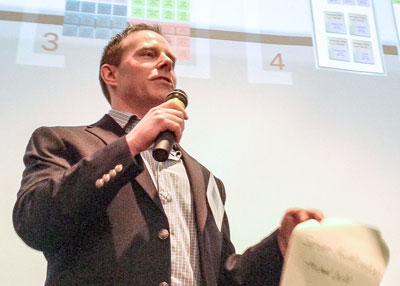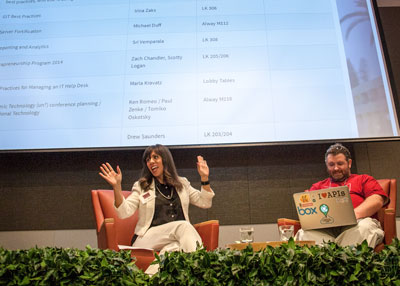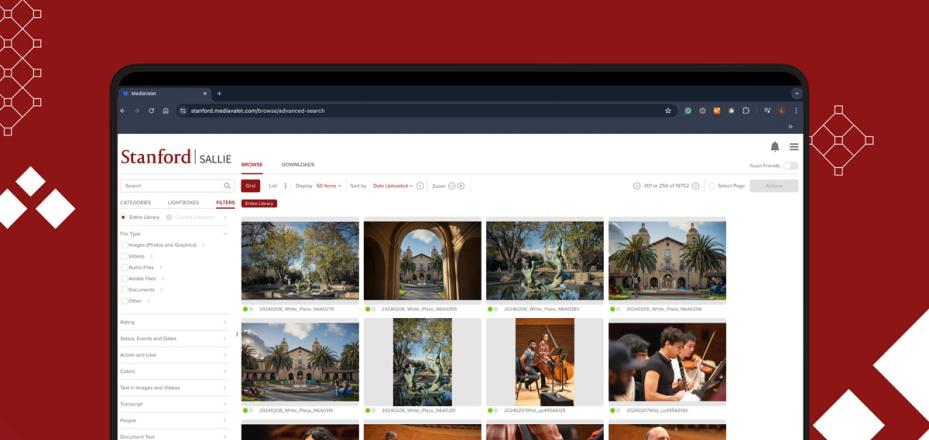IT Unconference kick-starts collaboration

Every autumn since 2011, around 400 IT professionals from all across campus set aside a day to share knowledge and talk about current or urgent topics. It’s the annual Stanford IT Unconference, a rare opportunity for technical staff and their managers to step outside defined roles to foster partnerships, find opportunities for collaboration, and look ahead together to the future.
At the 2013 event one of the topics, information security, happened to be both current and urgent. Chief information security officer Michael Tran Duff briefed attendees on policy changes and best practices for data encryption, mobile device management, and system administration. As expected, the audience listened intently to Duff’s prepared remarks, noting a hefty list of takeaways.
 Michael Tran Duff "pitches" server fortification
Michael Tran Duff "pitches" server fortificationWhat happened next exceeded everyone’s expectations, according to 2013’s lead organizer John DeSilva and co-founder Joe Little (both from Electrical Engineering). Key faculty stakeholders attended a subsequent ad hoc session on server fortification and, for the first time, exchanged concerns and ideas directly with Duff and other administrators and technicians. This breakthrough discussion initiated a “central policy-driving collaboration” that led to greater consensus on Stanford’s next steps to protect critical research and business data.
“That session on server fortification showed how the unconference builds bridges across organizations, at all levels, and provides an open forum where even the smallest among us can have a say.”
Law of two feet

Emcee Jo-Ann Cuevas and Scotty Logan lead 2013’s wrap-up
The Stanford IT Unconference is a facilitated event where the attendees create the agenda on the spot. Those who have ideas for a session take turns proposing their topics. Meanwhile, volunteers work with markers, sticky-notes, rolling whiteboards, and laptops to assign sessions to available rooms and time-slots and post the agenda on the web. Then, once the sessions begin, everyone is asked to follow the unconference Law of Two Feet: if you find yourself not learning or contributing at any time, use your two feet to find another session where you do learn or contribute.
“Stanford’s IT Unconference raises awareness around topics that otherwise wouldn’t get visibility,” says Christine Jacinto (University Human Resources) who, along with fellow co-founder Scotty Logan (IT Services), presented the event’s history, format, and outcomes at EDUCAUSE 2012.
The unconference and other participant-led meeting formats originated as Open Space in 1985. Unconferences have become popular in IT communities (e.g., BarCamp, CloudCamp) and among educators and educational technologists worldwide (e.g., THATCamp, EdCamp, TeachMeet).
The answer is in the room
Why an unconference vs. a regular conference? Two-time presenter Stephen Arod Shirreffs (Office of Student Affairs) answers with the cheeky premise “the audience is smarter than the organizers,” while sponsor and 2012 panelist Bill Clebsch (IT Services) sums up his support with a simple expression of confidence in Stanford’s people: “The answer is in the room.”

The 2012 unconference experience, in participants’ words
Results from the post-event attendee survey from Stanford’s 2013 event show that the audience and the answers are indeed among the top reasons people give for attending, according to co-founder and event registrar Marco Wise (University IT).
When asked “What did you get from the unconference that will contribute positively to your work,” participants acknowledged that the sessions expanded their network of IT colleagues and partners, generated new ideas for how to improve an aspect of IT at Stanford, and taught them something they didn’t previously know about IT resources offered here.
STLP and beyond
Stanford’s IT Unconference traces its origins to the Stanford Technical Leaders Program (STLP), which IT Services established in 2009 with partner MOR Associates to foster strategic thinking and collaboration among the hundreds of IT staff distributed across the university’s schools and departments. A group from the 2011 STLP class envisioned the event and went on to make it happen after graduating from the program, obtaining funding and material support from a list of campus organizations that has continued to grow each year. Sponsors now include all seven of Stanford’s schools, the Stanford University Libraries, Administrative Systems, and IT Services.
In January 2014, plans got underway for a fourth annual IT Unconference and, true to the original vision, the organizers were a mix of veterans and newcomers investing in an ongoing, collaborative community of event producers. All were volunteers committed to the notion that the best solutions emerge when practitioners and decision makers share ideas with each other across organizational and reporting boundaries.
DISCLAIMER: UIT News is accurate on the publication date. We do not update information in past news items. We do make every effort to keep our service information pages up-to-date. Please search our service pages at uit.stanford.edu/search.



